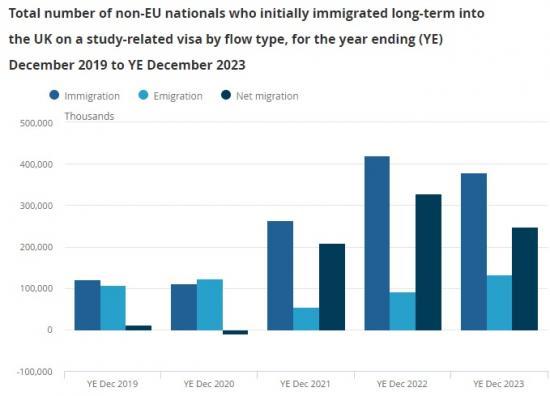Reason For International Migration, International Students Update - May 2024
25th May 2024

For the year ending (YE) December 2023, net migration of non-EU international migrants who initially arrived in the UK on a study-related visa decreased, falling to 247,000 compared with our updated estimate of 328,000 in the YE December 2022. This includes those who emigrated but had transitioned onto a different visa type during their time in the UK.
An increase in emigration and slight decrease in immigration led to a decrease in net migration. In the YE December 2023, 133,000 non-EU international students left the UK (up 42,000 from the YE December 2022), and 379,000 arrived in the UK on a study-related visa (down 40,000 from the YE December 2022).
Analysis shows long-term international students are staying in the UK longer and transitioning to other visa types, rather than leaving at the end of their studies; 40% of those who arrived in the YE December 2021 transitioned within two years of arrival, compared with 5% of those who arrived in the YE December 2018.
The proportion of non-EU nationals immigrating to the UK as dependants of someone on a study-related visa has increased over the last five years; from 8% (9,000) of those who arrived on a study-related visa in the YE December 2019 to 27% (102,000) in the YE December 2023.
Indian and Nigerian nationalities had the largest increases in study-related visas between the YE December 2018 and December 2022; Indian nationality increased from 13,100 to 142,200 and Nigerian nationality increased from 4,300 to 89,800.
Previously published estimates for the YE December 2022 are revised today; the YE December 2023 estimates published today are provisional and are subject to revision in future publications, as assumptions about length of stay or departure are replaced by data.
Overview
International students accounted for nearly two-fifths of non-EU immigration to the UK and almost three-fifths of non-EU emigration from the UK over the past five years (since 2019). Our latest long-term international migration estimates show a recent increase in emigration. If past patterns continue, we expect to see larger numbers of students who immigrated since the coronavirus (COVID-19) pandemic continue to leave as they complete their studies. However, new government policies introduced in recent years and further announcements of changes to net migration measures could impact the future migration patterns of international students.
Firstly the Graduate visa was introduced on 1 July 2021, which grants permission to stay in the UK for at least two years after successfully completing a course in the UK. More recently, from 1 January 2024 international students are no longer able to bring dependants on all but postgraduate research courses, and courses with government-funded scholarships. This policy change came into effect after the reference period for these estimates.
Students contribute to population change and have an impact on housing and public services, regardless of whether they leave at the end of their studies. They are included in our Long-term international migration, provisional: year ending December 2023 bulletin if they reside in the UK for 12 months or more, as they fall under the United Nations (UN) definition of a long-term migrant. Our Population and migration estimates - exploring alternative definitions: May 2023 article also highlights the challenges of separating out international students in our estimates.
This paper is a continuation of our Reason for international migration, international students update: November 2023 article. It expands on two methods: net migration by initial visa granted (which uses visa type at first arrival to the UK) and the cohort method (which follows the long-term migration patterns of international students over several years), to provide further insights into the characteristics of international students and their dependants identified in our provisional long-term international migration estimates.
At this stage in our research, we can only apply our methods to non-EU nationals (92% of international students and their dependants were non-EU nationals in the year ending (YE) December 2023) as this analysis uses Home Office Borders and Immigration data, which we only have for non-EU nationals currently. More information can be found in our Long-term international migration: quality assuring administrative data methodology.
These provisional estimates are released with the expectation that they may be revised and updated as further, more recent data become available.
Read the full ONS report HERE
